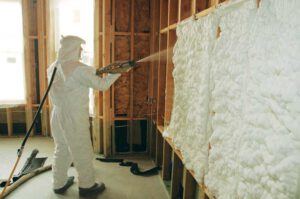Spray Foam Insulation is a great way to insulate your home. It is a chemical product made up of two materials: isocyanate and polyol resin. These materials combine to form a dense, flexible substance that can expand to thirty to sixty times its liquid volume. The result is an insulator that keeps your home warm and prevents drafts.
Open-cell spray foam is less expensive than closed-cell spray foam, but the downside is that the latter is denser and requires more material to cover the same area. On the other hand, closed-cell foam blocks sound waves to a much greater extent. Unfortunately, the higher cost of closed-cell spray foam means that the contractor must spend more money on materials and installation.
Closed-cell spray foam does not expand as quickly as open-cell foam, and it leaves behind interconnected closed air pockets. It’s also softer and more pliable. Open-cell foam insulation, on the other hand, has plenty of space between its cells and expands at an extremely fast rate. As a result, open-cell foam is very lightweight and breathable.
Open-cell spray foam costs between $2 and $10 per square foot. This type is typically used in wall cavities and has a lower R-value per inch than closed-cell foam. Moreover, open-cell spray foam is more durable than closed-cell foam and requires less labor for installation. However, it might require an additional vapor barrier.
The cost of closed-cell spray foam insulation can range from $1 to $2 per square foot, depending on its thickness and the number of walls. This cost is dependent on factors such as the square footage and other factors, including the cost of labor. Nonetheless, it’s easy to see that open-cell spray foam is the cheaper option.
The decision on what type of spray foam to install is an important one. There are two different types of spray foam: open-cell foam is cheaper and allows more air to circulate, while the closed-cell foam is more expensive but offers twice the R-value.
Closed-cell spray foam insulation has the advantage of being more dense and able to expand very little. This makes it ideal for the roof, where it creates a solid air barrier and can add strength to the structure. It also has excellent resistance to floodwater and damage. It can conceal any leaks in the structure.
Closed-cell foam has superior structural integrity, which is important in hurricane-prone areas. This dense material also provides an effective vapor barrier. The foam has a high R-value, which is an important consideration when insulating a building.
The density of closed-cell foam varies greatly. Open-cell foam weighs between 0.4 and 0.5 pounds per cubic foot, while the closed-cell foam is three to four times heavier. As a result, closed-cell foam can be molded to look like wood or marble.
The R-value of closed-cell spray foam is higher than that of open-cell foam. In addition, closed-cell foam is more durable and offers better resistance to air leakage and moisture. Closed-cell foam is more expensive than open-cell spray foam. It also requires professional installation.
The roof of a building has a lot of unique characteristics. Closed-cell foam can be applied to the underside of the roof sheathing or even blown into the cavity space of the roof. This makes it more effective for preventing downward heat flow.
Closed-cell spray foam insulation is less suitable for other parts of a building. This is because of the difference in density between the open and closed-cell foam.
A drafty house can be a major inconvenience, but there are ways to permanently fix this problem. The first step is to identify the areas that allow air leakage. These areas are often in the attic or basement. This is because of a stack effect, which causes heated air to rise to a higher pressure near the top of the house. This then forces cold air to enter the lower parts of the home while warmer air is forced out through the leaks.
Drafts can also come from uninsulated walls. In particular, the attic is an area that can lose a great deal of air. This leakage can cause damage to the roof. To solve this problem, you can install spray foam insulation. Besides sealing these areas, it also seals up cracks around electrical outlets and other protrusions into the home.
Another way to prevent drafts is to install an air barrier on the walls. This type of insulation is made of a compound called icynene, which is a great insulator. Since air is trapped in this substance, it cannot move around, which creates a barrier. It is important to note that even the smallest gaps in the insulation can drastically affect the house’s temperature.
